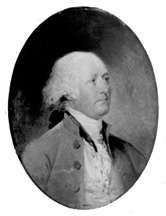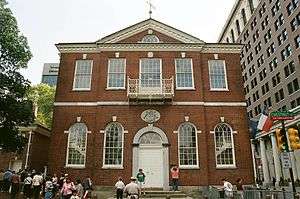5th United States Congress
| 5th United States Congress | |||||||||||||||||||||||||||||
| |||||||||||||||||||||||||||||
The Fifth United States Congress was a meeting of the legislative branch of the United States federal government, consisting of the United States Senate and the United States House of Representatives. It met at Congress Hall in Philadelphia, Pennsylvania from March 4, 1797 to March 4, 1799, during the first two years of John Adams's presidency.
The apportionment of seats in this House of Representatives was based on the First Census of the United States in 1790. Both chambers had a Federalist majority.
.jpg)
Major events
- March 4, 1797 – John Adams and Thomas Jefferson became President and Vice President of the United States
- July 8, 1797 - The Senate expelled Tennessee Senator William Blount for conspiring with the British
- July 11, 1798 - The United States Marine Corps was established
- XYZ Affair in the U.S., followed by naval skirmishes but no war is declared
Major legislation
- April 30, 1798: The U.S. Department of the Navy was established, Sess. 2, ch. 35, 1 Stat. 553
- June 18, 1798: Alien and Sedition Acts: ("An Act to establish a uniform rule of naturalization") (Naturalization Act of 1798), Sess. 2, ch. 54, 1 Stat. 566
- June 25, 1798: Alien and Sedition Acts: ("An Act concerning Aliens"), Sess. 2, ch. 58, 1 Stat. 570
- July 6, 1798: Alien and Sedition Acts: ("An Act respecting Alien Enemies"), Sess. 2, ch. 66, 1 Stat. 577
- July 9, 1798: Act Further to Protect the Commerce of the United States, Sess. 2, ch. 68, 1 Stat. 578
- July 11, 1798: The United States Marine Corps was established, Sess. 2, ch. 72, 1 Stat. 594
- July 14, 1798: Alien and Sedition Acts: ("An Act for the punishment of certain crimes against the United States") (Sedition Act), Sess. 2, ch. 74, 1 Stat. 596
- July 16, 1798: Marine Hospital Service Act ("An Act for the relief of sick and disabled Seamen"), Sess. 2, ch. 77, 1 Stat. 605
Territories organized
- April 7, 1798 - Mississippi Territory was organized, Sess. 2, ch. 28, 1 Stat. 549. It was formerly a portion of Georgia and South Carolina
Treaties ratified
- June 7, 1797: Treaty of Tripoli between the United States and Tripoli.[1]
- July 7, 1797: Existing treaties with France were rescinded, Sess. 2, ch. 67, 1 Stat. 578
Party summary
Details on changes are shown below in the "Changes in membership" section.
Senate
| Party (shading shows control) |
Total | Vacant | ||
|---|---|---|---|---|
| Democratic- Republican (DR) |
Federalist (F) | |||
| End of the previous congress | 11 | 21 | 32 | 0 |
| Begin | 9 | 22 | 31 | 1 |
| End | ||||
| Final voting share | 29.0% | 71.0% | ||
| Beginning of the next congress | 9 | 22 | 31 | 1 |
House of Representatives

| Party (shading shows control) |
Total | Vacant | ||
|---|---|---|---|---|
| Democratic- Republican (DR) |
Federalist (F) | |||
| End of the previous congress | 59 | 47 | 106 | 0 |
| Begin | 49 | 56 | 105 | 1 |
| End | 50 | 57 | 107 | 0 |
| Final voting share | 46.7% | 53.3% | ||
| Beginning of the next congress | 46 | 60 | 106 | 0 |

Leadership
Senate
- President: Thomas Jefferson (DR)
- President pro tempore: William Bradford (F), elected July 6, 1797
- Jacob Read (F), elected November 22, 1797
- Theodore Sedgwick (F), elected June 27, 1798
- John Laurance (F), elected December 6, 1798
- James Ross (F), elected March 1, 1799
House of Representatives
Members
This list is arranged by chamber, then by state. Senators are listed in order of seniority, and Representatives are listed by district.
Senate
Senators were elected by the state legislatures every two years, with one-third beginning new six-year terms with each Congress. Preceding the names in the list below are Senate class numbers, which indicate the cycle of their election. In this Congress, Class 1 meant their term began in this Congress, requiring reelection in 1802; Class 2 meant their term ended with this Congress, requiring reelection in 1798; and Class 3 meant their term began in the last Congress, requiring reelection in 1800.
Connecticut
Delaware
Georgia
Kentucky
Maryland
Massachusetts
New Hampshire
New Jersey
New York
|
North Carolina
Pennsylvania
Rhode Island
South Carolina
Tennessee
Vermont
Virginia
|
 President pro tempore of the Senate Jacob Read |
House of Representatives
Changes in membership
The count below reflects changes from the beginning of this Congress
Senate
There were 9 resignations, 2 deaths, 1 expulsion, 1 late selection, and 2 elections to replace appointees. Neither party had a net gain of seats.
| State (class) |
Vacator | Reason for change | Successor | Date of successor's formal installation |
|---|---|---|---|---|
| Tennessee (1) |
Vacant | Tennessee failed to elect a Senator on time | William Cocke (DR) | Appointed May 15, 1797 |
| Tennessee (2) |
William Blount (DR) | Expelled July 8, 1797 | Joseph Anderson (DR) | Elected September 26, 1797 |
| Tennessee (1) |
William Cocke (DR) | Interim appointment until September 26, 1797 | Andrew Jackson (DR) | Elected September 26, 1797 |
| Rhode Island (2) |
William Bradford (F) | Resigned sometime in October, 1797 | Ray Greene (F) | Elected November 13, 1797 |
| Vermont (1) |
Isaac Tichenor (F) | Resigned October 17, 1797 | Nathaniel Chipman (F) | Elected October 17, 1797 |
| Maryland (3) |
John Henry (F) | Resigned December 10, 1797 | James Lloyd (F) | Elected December 11, 1797 |
| New York (1) |
Philip John Schuyler (F) | Resigned January 3, 1798 | John Sloss Hobart (F) | Elected January 11, 1798 |
| Delaware (2) |
John Vining (F) | Resigned January 19, 1798 | Joshua Clayton (F) | Elected January 19, 1798 |
| Tennessee (1) |
Andrew Jackson (DR) | Resigned sometime in April, 1798 | Daniel Smith (DR) | Appointed October 6, 1798 |
| New York (1) |
John Sloss Hobart (F) | Resigned April 16, 1798 | William North (F) | Appointed May 5, 1798 |
| Delaware (2) |
Joshua Clayton (F) | Died August 11, 1798 | William H. Wells (F) | Elected January 17, 1799 |
| New York (1) |
William North (F) | Interim appointment until August 17, 1798 | James Watson (F) | Elected August 17, 1798 |
| New Jersey (1) |
John Rutherfurd (F) | Resigned November 26, 1798 | Franklin Davenport (F) | Appointed December 5, 1798 |
| South Carolina (2) |
John Hunter (DR) | Resigned November 26, 1798 | Charles Pinckney (DR) | Elected December 6, 1798 |
| Virginia (2) |
Henry Tazewell (DR) | Died January 24, 1799 | Vacant | Not filled in this Congress |
House of Representatives
There were 9 resignations and 3 deaths. The Federalists had a 1-seat net loss and the Democratic-Republicans had a 1-seat net gain.
| District | Vacator | Reason for change | Successor | Date successor seated |
|---|---|---|---|---|
| Vermont 2nd |
Vacant | Daniel Buck (F) had been re-elected, but declined to serve. | Lewis R. Morris (F) | May 24, 1797 |
| Rhode Island At-large |
Elisha Potter (F) | Resigned sometime in 1797 | Thomas Tillinghast (F) | Seated November 13, 1797 |
| South Carolina 1st |
William L. Smith (F) | Resigned July 10, 1797 | Thomas Pinckney (F) | Seated November 23, 1797 |
| Massachusetts 11th |
Theophilus Bradbury (F) | Resigned July 24, 1797 | Bailey Bartlett (F) | Seated November 27, 1797 |
| New Hampshire At-large |
Jeremiah Smith (F) | Resigned July 26, 1797 | Peleg Sprague (F) | Seated December 15, 1797 |
| Connecticut At-large |
James Davenport (F) | Died August 3, 1797 | William Edmond (F) | Seated November 13, 1797 |
| Tennessee At-large |
Andrew Jackson (DR) | Resigned sometime in September, 1797 to become U.S. Senator | William C.C. Claiborne (DR) | Seated November 23, 1797 |
| Pennsylvania 5th |
George Ege (F) | Resigned sometime in October, 1797 | Joseph Hiester (DR) | Seated December 1, 1797 |
| Pennsylvania 4th |
Samuel Sitgreaves (F) | Resigned sometime in 1798 | Robert Brown (DR) | Seated December 4, 1798 |
| North Carolina 10th |
Nathan Bryan (DR) | Died June 4, 1798 | Richard Dobbs Spaight (DR) | Seated December 10, 1798 |
| Pennsylvania 1st |
John Swanwick (DR) | Died August 1, 1798 | Robert Waln (F) | Seated December 3, 1798 |
| Connecticut At-large |
Joshua Coit (F) | Died September 5, 1798 | Jonathan Brace (F) | Seated December 3, 1798 |
| Virginia 9th |
William Giles (DR) | Resigned October 2, 1798 | Joseph Eggleston (DR) | Seated December 3, 1798 |
Committees
Lists of committees and their party leaders.
Senate
House of Representatives
- Claims
- Commerce and Manufactures
- Elections
- Revisal and Unfinished Business
- Rules (Select)
- Standards of Official Conduct
- Ways and Means
- Whole
Joint committees
Employees
Senate
- Secretary: Samuel A. Otis of Massachusetts, elected April 8, 1789
- Doorkeeper: James Mathers of New York, elected April 7, 1789
- Chaplain: William White, Episcopalian, elected December 9, 1790
House of Representatives
- Clerk: Jonathan W. Condy of Pennsylvania, elected May 15, 1797
- Sergeant at Arms: Joseph Wheaton of Rhode Island, elected May 15, 1797
- Doorkeeper: Thomas Claxton, elected May 15, 1797
- Chaplain: Ashbel Green, Presbyterian, elected May 15, 1797
See also
- United States elections, 1796 (elections leading to this Congress)
- United States elections, 1798 (elections during this Congress, leading to the next Congress)
References
- ↑ "Executive Journal (Fourteenth session)". Journal of the Executive Proceedings of the Senate of the United States of America. Library of Congress. June 7, 1797. p. 244.
- Martis, Kenneth C. (1989). The Historical Atlas of Political Parties in the United States Congress. New York: Macmillan Publishing Company.
- Martis, Kenneth C. (1982). The Historical Atlas of United States Congressional Districts. New York: Macmillan Publishing Company.
External links
- Statutes at Large, 1789-1875
- Senate Journal, First Forty-three Sessions of Congress
- House Journal, First Forty-three Sessions of Congress
- Biographical Directory of the U.S. Congress
- U.S. House of Representatives: House History
- U.S. Senate: Statistics and Lists

